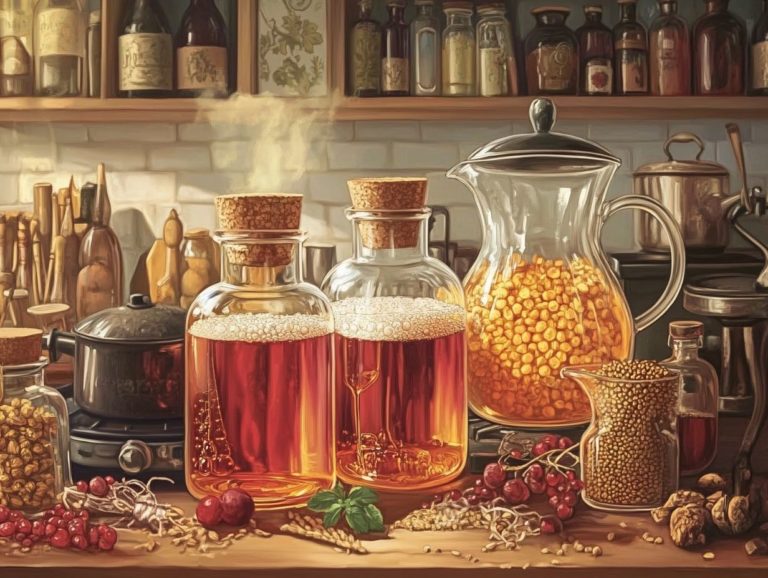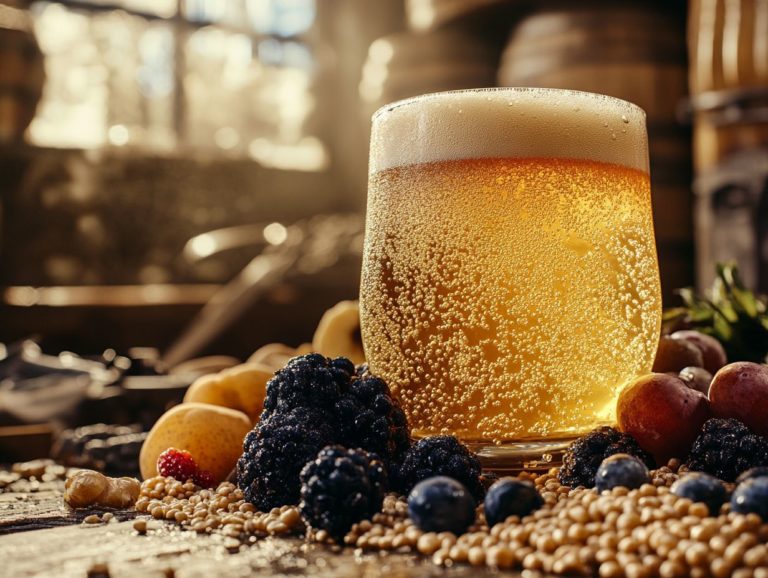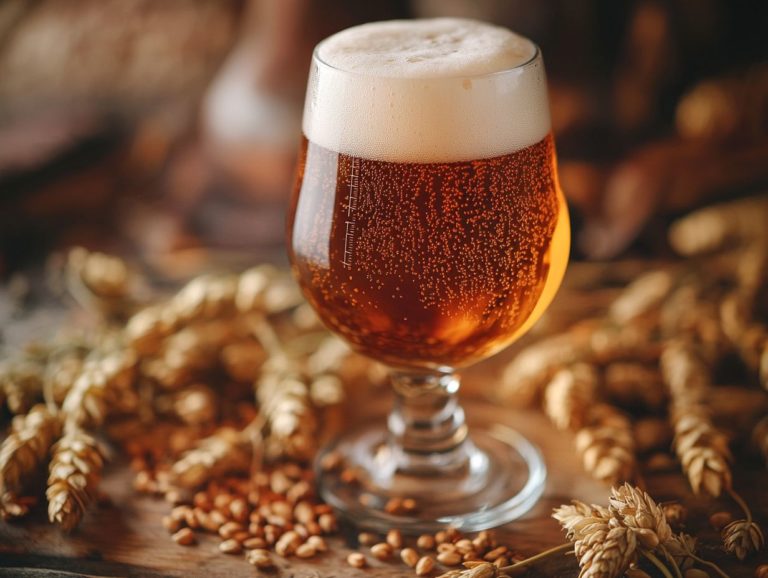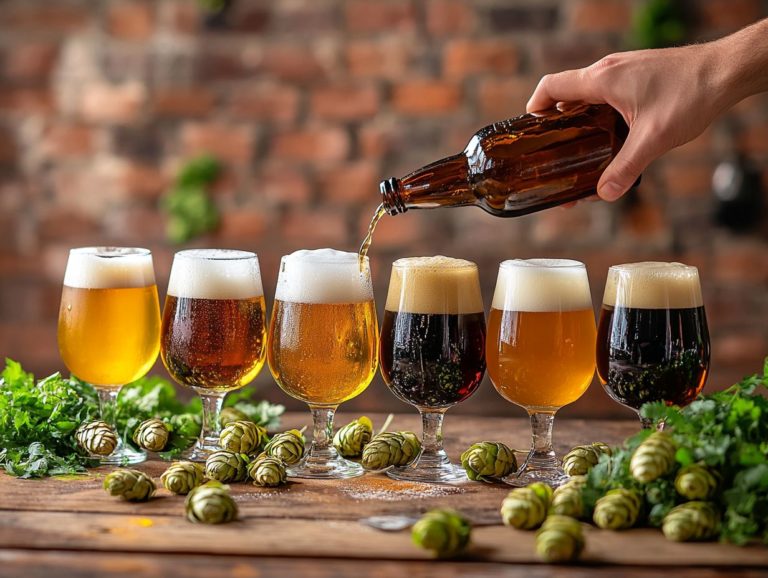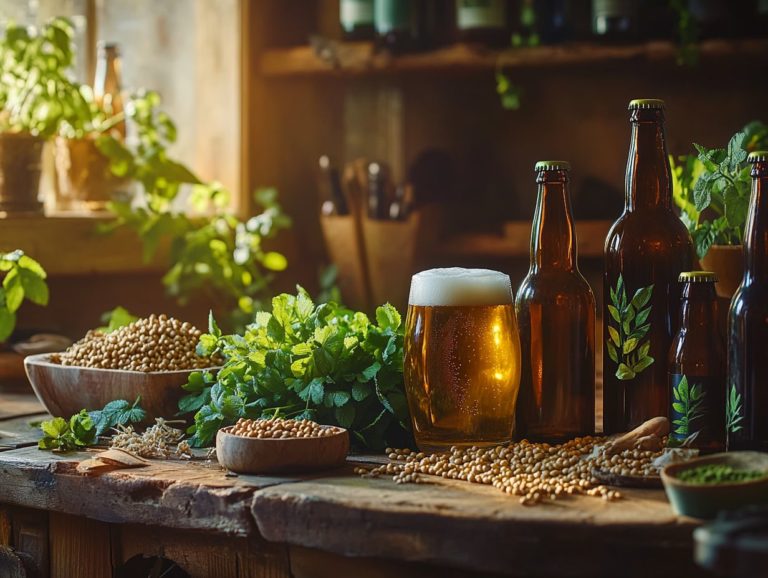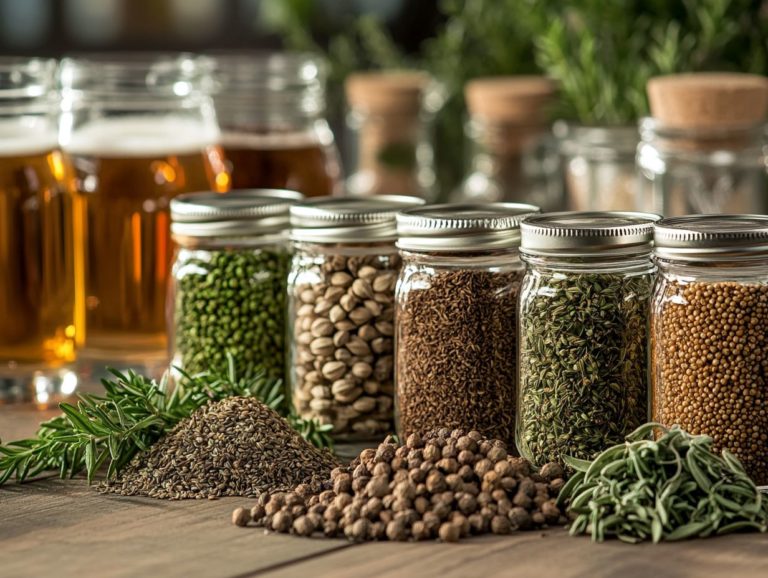The Secrets of Successful Beer Ingredient Pairing
Beer ingredient pairing is an art that can elevate your dining experience, transforming simple meals into true culinary masterpieces.
By understanding how to match various beer styles with your food, you can enhance flavors and achieve a balance in your dishes that may surprise you.
This article delves into the fundamentals of beer pairing, exploring its significance and offering practical tips for selecting the perfect brew to complement your meal. You’ll also find recipes and guidelines for crafting your own pairings at home.
From classic combinations to common pitfalls, you’ll discover how to unlock the full potential of beer in your culinary adventures, ensuring each dining experience is nothing short of exceptional.
Get ready to explore various flavors and exciting pairings that break the rules of traditional beer and food matching!
Contents
- Key Takeaways:
- What Is Beer Ingredient Pairing?
- Why Is Beer Ingredient Pairing Important?
- How To Choose The Right Beer For Your Meal?
- Beer and Food Pairing Guide
- What Are The Best Beer and Food Pairings?
- What Are Some Common Mistakes in Beer Ingredient Pairing?
- How To Experiment With Beer Ingredient Pairing?
- How do you balance flavors when pairing beer ingredients?
- Can any ingredient be used in beer pairing?
- Why is it important to complement ingredients in beer pairing?
- How does the style of beer affect ingredient pairing?
- Are there any tips for experimenting with beer ingredient pairing?
Key Takeaways:
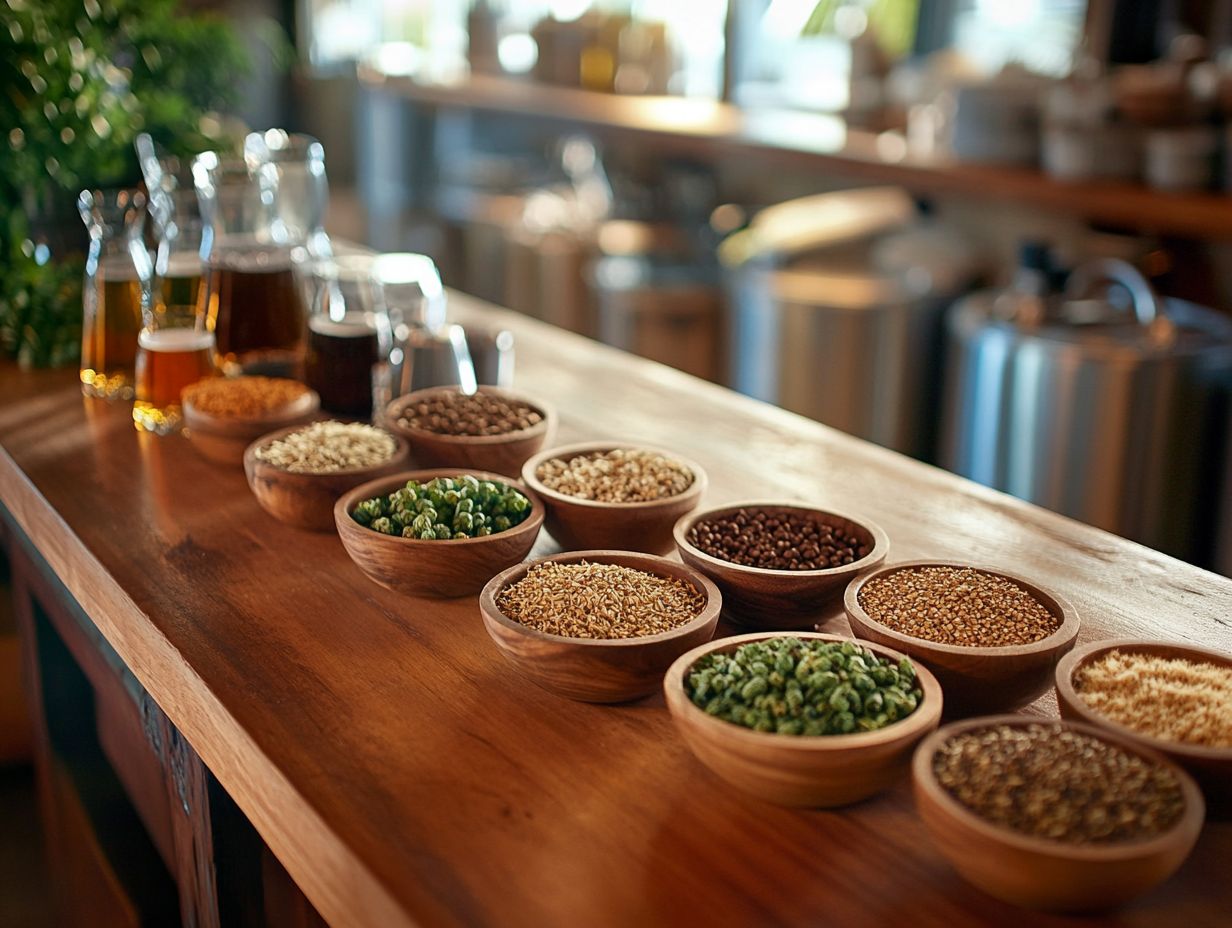
- Consider the flavor profile of both the beer and food when pairing.
- Don’t overpower the food with a strong or heavily flavored beer.
- Don’t be afraid to experiment with different styles and flavors of beer in your pairings.
What Is Beer Ingredient Pairing?
Beer ingredient pairing is your gateway to a culinary adventure, where you can explore the exquisite relationships between various beer styles and food, enriching both the flavors and your dining experience.
Understanding how the distinct characteristics of different beers like the sweetness or bitterness from malt and hops can beautifully complement or intriguingly contrast with the flavors of dishes such as seafood, cheese, and desserts is essential.
The perfect pairings not only bring out the unique tasting notes of the beer but also elevate your overall palate experience, inviting you to embark on a delightful journey through intensity and resonance across a myriad of culinary combinations.
Why Is Beer Ingredient Pairing Important?
Grasping the significance of beer ingredient pairing reveals its remarkable ability to elevate culinary experiences and enrich flavor profiles, allowing you to savor your meals in a more profound manner.
Acknowledge the diverse flavors and intensity levels in both beer and food. This helps craft a harmonious symphony of tastes that complements one another, transforming an ordinary meal into an extraordinary adventure. This involves understanding the sweetness, bitterness, umami, and carbonation present in both elements.
Choosing the right beer can make your meal unforgettable. For example, pairing a robust Stout with a rich umami dish creates a delightful contrast.
How To Choose The Right Beer For Your Meal?
Choosing the perfect beer to accompany your meal requires an appreciation for the subtle interplay of flavors and intensity that can elevate your dining experience or, conversely, overshadow it.
As you embark on this flavorful journey, consider the flavor profile of your dish, the intensity of both the food and the beer, and the cooking techniques involved, whether it’s grilling, steaming, or frying.
Furthermore, exploring regional pairings can reveal a treasure trove of harmonious combinations that honor local traditions, transforming each sip and bite into a delightful adventure and guiding you through an exploration of complementary tastes.
Beer and Food Pairing Guide
1. Consider the Flavor Profile
Considering the flavor profile is essential when you re pairing beer with food. It allows you to align specific tasting notes with the unique characteristics of your dish.
Different beer styles come with distinct flavor profiles. For instance, a hoppy IPA can amplify the bitterness in a spicy dish, while a malty porter beautifully complements the sweetness of chocolate desserts.
By analyzing the flavors in both the beer and the food, you can create a balanced pairing that enhances your overall dining experience.
To effectively assess flavor compatibility, you need to recognize key components like sweetness, bitterness, hops, and malt. A crisp lager, for example, harmonizes wonderfully with grilled chicken. Its light body and subtle sweetness contrast beautifully with the savory notes of the meat.
On the other hand, a rich stout can elevate the flavors in a hearty beef stew, where the beer s roasted malt mirrors the umami characteristics of the dish.
Understanding these nuances isn t just a cooking adventure; it s an exploration of how flavors interact to create a symphony on your palate.
2. Match Intensity
Matching the intensity between beer and food is essential for crafting a culinary experience that captivates your palate. A robust stout can stand up beautifully to the bold flavors of BBQ ribs.
Meanwhile, a light Belgian Witbier may be more fitting for delicate salads and seafood, allowing both elements to shine in an enjoyable contrast.
Understanding flavor intensities can transform your dining experience! When looking into pairings, consider the boldness of each dish and drink.
For instance, a spicy curry often demands a hoppy IPA to balance the heat, as its bitterness cuts through the richness of the sauce. Conversely, lightly smoked fish might find a perfect companion in a crisp lager, allowing those subtle flavors to emerge.
Assessing intensity requires tasting with intention. Identify the primary flavors and note how they either compete or complement one another.
Contrast can be just as thrilling as harmony. Don t shy away from experimenting! Pairing sweet desserts with tart sours can yield delightful surprises, enhancing your overall gastronomic experience.
Similarly, salty and sour combinations can create unique and memorable pairings.
3. Take into Account the Cooking Method
The cooking method you choose to prepare a dish can dramatically influence the flavors and textures that emerge, shaping your beer pairing decisions.
Take grilled meats, for instance. They often develop a delightful charred, smoky flavor that harmonizes beautifully with hoppy beers like IPAs.
Fried foods thrive on the crispness and carbonation of a Pilsner, enhancing your dining experience. Understanding how different cooking techniques enhance or alter flavor profiles is crucial for crafting the perfect beer and food combination.
Baking creates browning, adding depth and complexity to dishes like roasted vegetables. These flavors are ideally complemented by a smooth amber ale that highlights their caramelization.
Steaming retains the natural flavors and moisture of ingredients, making it excellent for delicate seafood. A light, citrusy wheat beer won t overpower the dish.
Pairing Brussels sprouts with certain beer styles can amplify their umami notes. Every cooking technique not only changes the tactile sensation but also plays a crucial role in defining the taste profile of the accompanying beer.
This invites you to explore thoughtfully the world of food and beverage pairings, leading to delightful culinary adventures.
Now it’s your turn to experiment! Grab a beer and a dish, and see what amazing flavors you can create!
What Are The Best Beer and Food Pairings?
The finest beer and food pairings have the power to elevate an ordinary meal into an extraordinary culinary journey, revealing the delightful dance of diverse flavors and textures. Imagine the thrilling explosion of flavors when IPAs meet spicy dishes, or Wheat Beers perfectly complementing fresh salads and succulent seafood.
Picture Stouts enriching the experience of decadent chocolate desserts, while Pilsners add a crisp balance to fried foods. These thoughtful pairings not only enhance the character of the beer but also amplify the flavors of the dish, inviting you to explore a realm of complementary tastes that promises adventure for your palate through both contrast and harmony. Don’t miss out on the chance to elevate your meals!
1. IPAs with Spicy Foods
IPAs are celebrated for their bold bitterness and hoppy flavors, making them an exceptional choice to pair with spicy foods that can match their intensity. The bitterness of IPAs serves as a perfect counterbalance to the heat in dishes like spicy curries or tacos, creating a complex flavor experience that elevates both the beer and the meal.
Salty snacks also pair well with IPAs, as the bitterness cuts through the saltiness, creating a balanced combination. This pairing transforms your dining experience into an adventurous journey for the palate, turning an ordinary meal into a memorable event filled with bold, contrasting notes.
Picture this: the crisp, citrusy notes of hops collide with the fiery kick of garlic and chili in a Szechuan stir-fry, resulting in an explosion of flavors that tantalizes your taste buds. Similarly, the tropical fruitiness often found in certain IPAs beautifully complements spicy fish tacos, as the acidity from lime cuts through the richness of the fish while the hops gently mellow the spice.
Dishes like buffalo wings or spicy barbecue ribs thrive in this harmonious alliance, with the layers of bitterness interacting with the sauce’s heat, enhancing the overall dining experience. Ultimately, this delightful juxtaposition offers you an engaging sensory adventure that keeps you coming back for more.
This perfect pairing of beer and food demonstrates the importance of considering flavor intensity to achieve a balanced dining experience.
4. Think About Regional Pairings
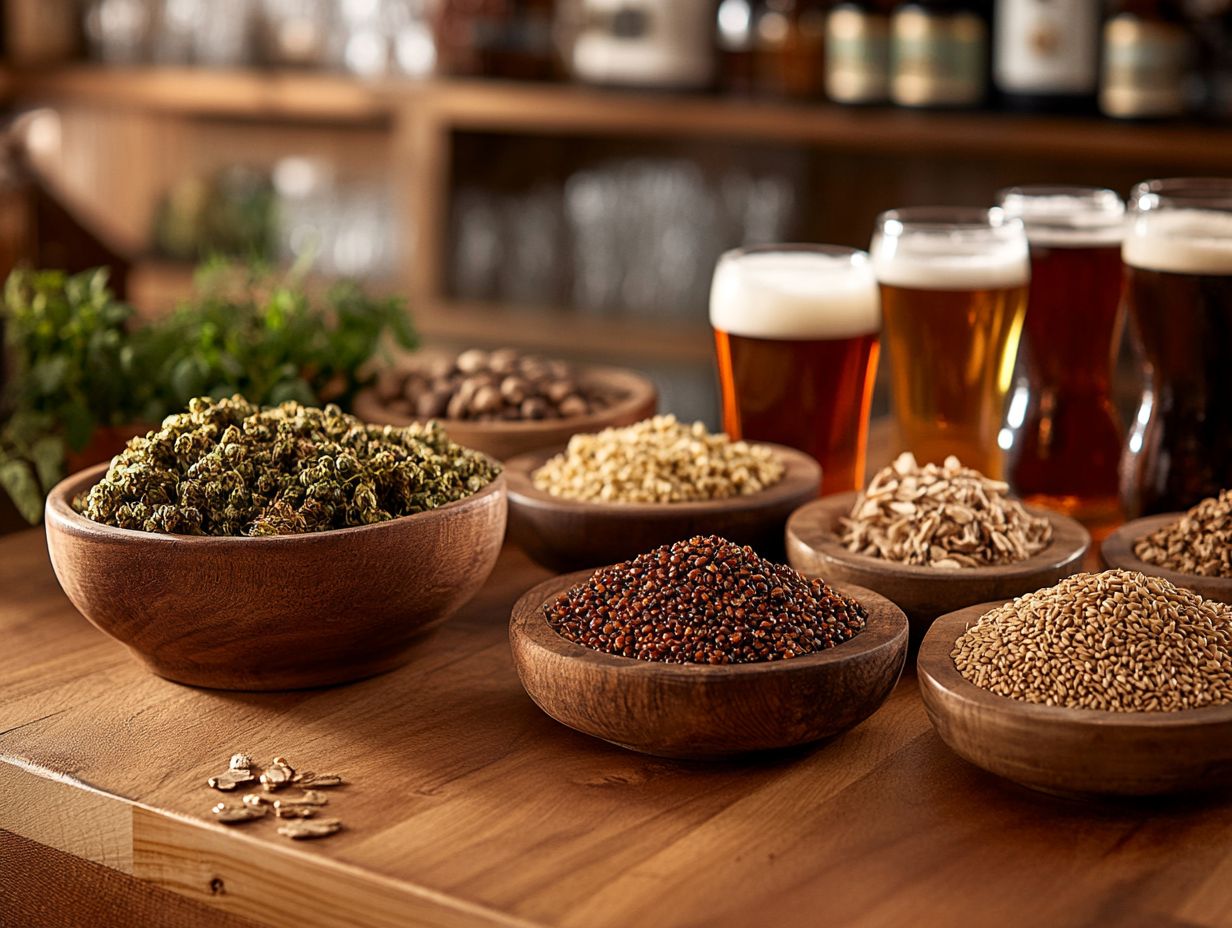
Considering regional pairings can elevate your culinary experience, allowing you to celebrate local traditions while enhancing the overall flavor profile by aligning cultural dishes with the perfect beer styles. For instance, imagine how a refreshing Belgian Witbier pairs beautifully with a classic seafood dish, or how a rich Porter complements hearty stews typical of colder climates.
Delving into regional flavors can lead you to delightful discoveries in the world of food and beer pairing, opening up new avenues for exploration and discovery. The unique characteristics of local ingredients are pivotal in crafting these successful combinations.
Picture the vibrant hops from the Pacific Northwest working well together with the spiciness of a savory gumbo from Southern Louisiana, creating a delicious union of land and sea. Similarly, envision a crisp lager brewed with locally sourced corn enhancing the experience of savoring traditional Mexican street tacos, showcasing the freshness of both the food and drink.
This thoughtful approach supports local breweries and farmers, weaving a rich tapestry of flavors at your table, where every sip and bite narrates a story steeped in the region’s heritage.
2. Wheat Beers with Salads and Seafood
Wheat beers have a light and refreshing character. They are perfect for delicate salads and seafood, enhancing fresh flavors without overwhelming your palate.
The subtle tasting notes of citrus and spice create a delightful contrast to the natural sweetness of seafood or the crispness of salad greens, promoting a harmonious balance that elevates your dining experience. This pairing truly showcases the beauty of complementary flavors in culinary exploration.
Picture this: a light, citrusy wheat beer alongside a mixed greens salad topped with grilled shrimp and a zesty vinaigrette. The beer s bubbly nature effortlessly cuts through the richness of the shrimp while echoing the bright lemon notes in the dressing.
Alternatively, imagine savoring a Weissbier, a type of wheat beer, with seared scallops drizzled in mango salsa. This exquisite balance allows the fruity undertones of the beer to accentuate the sweetness of the scallops.
Such combinations not only highlight the freshness of the ingredients but also bring out the best in both the dish and the beverage, transforming mealtime into a truly flavorful occasion.
3. Stouts with Chocolate Desserts
Stouts are an exquisite choice for pairing with chocolate desserts, as their rich and robust flavors beautifully echo the sweetness of chocolate, crafting a truly delightful tasting experience.
The coffee and chocolate notes that are characteristic of stouts not only enhance the dessert s flavors but also provide a satisfying contrast to any bitterness, transforming each bite and sip into a celebration of indulgence. This pairing exemplifies how two flavors can resonate perfectly when brought together.
Consider, for example, a decadent chocolate lava cake with its luscious, gooey center; it finds an exceptional partner in the deep, malty layers of a stout. The beer’s full-bodied nature elevates the molten chocolate s intensity, resulting in a harmonious blend of flavors with each mouthful.
Similarly, a dark chocolate mousse, with its airy yet luxurious texture, pairs beautifully with the stout s creamy mouthfeel and roasted undertones, enriching the overall experience.
The subtle sweetness and complexity of stouts also enhance brownies or chocolate torte, transforming a simple dessert into an extraordinary indulgence.
This synergy between stouts and chocolate desserts not only delights the palate but also showcases the beautiful interplay of textures and flavors, ensuring that each dessert remains unforgettable.
4. Pilsners with Fried Foods
Pilsners, with their crisp and refreshing carbonation, are an ideal match for fried foods, effortlessly cutting through the richness and elevating your dining experience.
The light body and clean finish of a Pilsner provide a harmonious balance against the savory flavors of dishes like fried chicken or calamari, accentuating the textures while cleansing your palate between bites.
Consider indulging in a plate of crispy fish and chips; the subtle bitterness of the Pilsner complements the flaky texture of the fried fish, expertly offsetting the dish s oiliness.
Likewise, when you savor tempura vegetables, the light batter finds a refreshing partner in this beer style, allowing the vibrant flavors of the vegetables to shine without being overshadowed. The carbonation in Pilsners cuts through the fried batter, leaving you with a truly delightful experience.
Sipping on a Pilsner alongside fried foods not only enhances the flavors but also elevates those social dining moments, making them the perfect companions for your gatherings. Don t miss out on the chance to elevate your gatherings with these exciting pairings!
What Are Some Common Mistakes in Beer Ingredient Pairing?
In the realm of beer ingredient pairing, even the most seasoned enthusiasts can stumble into common pitfalls that diminish the dining experience. One prevalent mistake is selecting a beer with an overly robust flavor profile, which can easily overshadow the delicate nuances of your dish.
Furthermore, failing to take into account factors like carbonation levels and serving temperatures can result in less-than-optimal pairings, ultimately missing the opportunity to create that harmonious resonance between the beer and the food.
1. Overpowering the Food
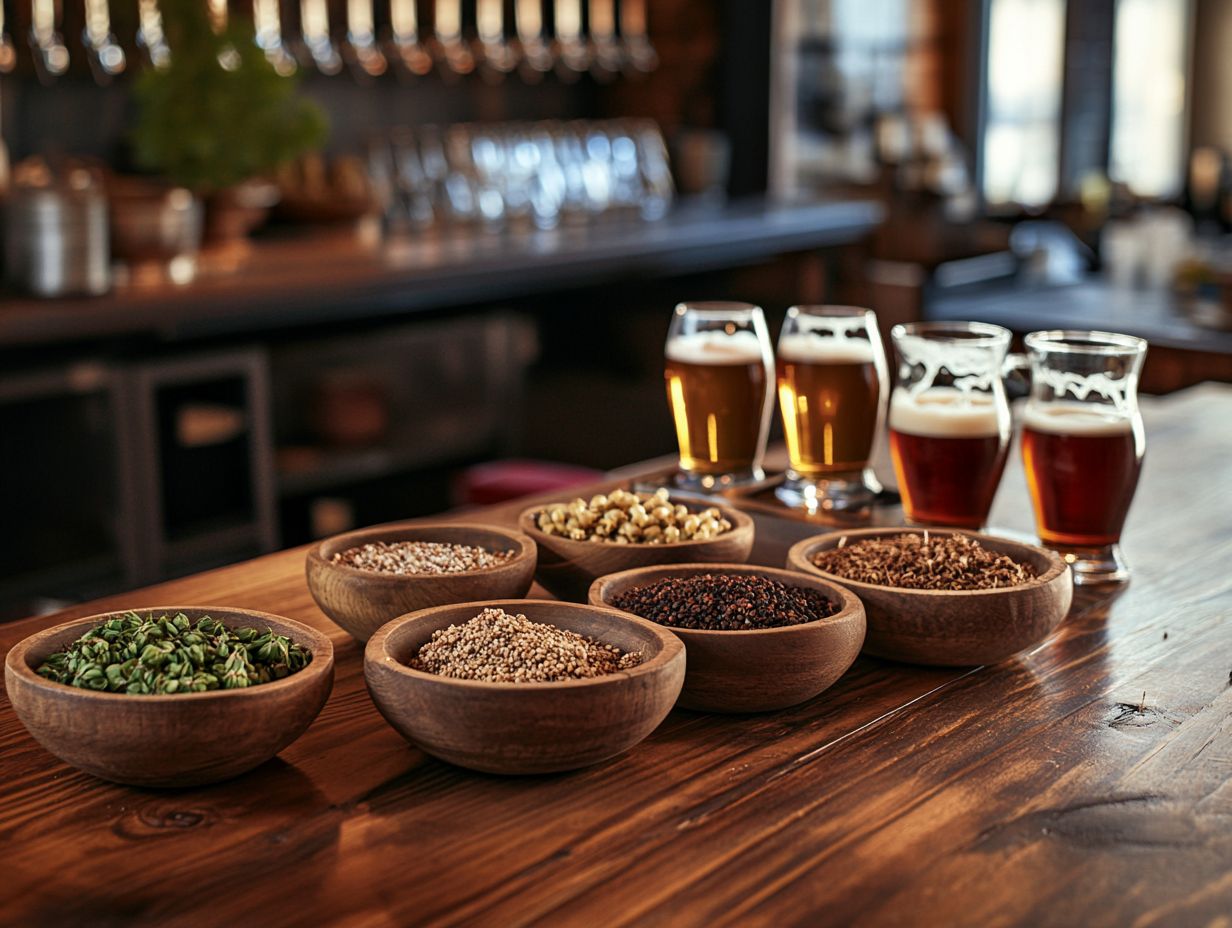
One of the most prevalent mistakes in beer ingredient pairing is selecting a beer that overwhelms the food, resulting in an unbalanced dining experience. When you choose a beer with an intense flavor profile, like a double IPA, which is a strong type of beer known for its hoppy flavor, it can easily overshadow the delicate nuances of a dish such as grilled fish.
This leads to a clash rather than a harmonious pairing. Recognizing the significance of balance is crucial for crafting an enjoyable culinary adventure.
For example, a rich stout can completely mask the subtle spices in a light curry. This leaves the meal feeling one-dimensional.
Instead, consider opting for a refreshing pilsner or a wheat beer with mild citrus notes; these choices can enhance the dish by highlighting its flavors without overpowering them.
Similarly, pairing a robust barleywine with a simple salad would likely overshadow the fresh ingredients. A light K lsch would be a much better alternative.
By prioritizing complementary flavors, you’ll create a more satisfying dining experience that allows both the food and the beer to shine.
Experimenting with pairings like a hoppy IPA with cheese or a Belgian Witbier with seafood can lead to unique and delightful flavor discoveries.
2. Ignoring the Carbonation
Overlooking the role of carbonation in beer can lead to pairings that simply miss the mark, detracting from your overall taste experience. When this aspect is neglected, you might find that a particular brew doesn’t elevate the dish it s meant to accompany, resulting in a less satisfying meal.
High carbonation levels are especially skilled at enhancing the perception of freshness, making it essential to consider when selecting beers for fried or fatty foods. For instance, a crisp pilsner with lively bubbles can effortlessly cut through the richness of fried calamari.
On the other hand, a low-carbonation stout may fall short, potentially overwhelming your palate with its heavy flavors.
Ignoring carbonation is a common misstep that can result in disastrous pairings. An overly carbonated beer could clash with delicate seafood, while a flat beer might leave your flavor profiles feeling unbalanced and uninspiring.
To steer clear of such pitfalls, it’s crucial to pay attention to the carbonation characteristics of your beverage, as they can profoundly influence your overall dining experience.
3. Not Considering the Temperature
Not taking into account the temperature at which you serve beer can greatly compromise the quality of your pairing. This can dull the intricate flavors and aromas that should tantalize your senses.
For instance, serving a hoppy IPA too cold can suppress its lively hop character. Conversely, a rich stout served at too warm a temperature can become excessively heavy and quite unpleasant.
Recognizing the ideal serving temperatures for different beer styles is crucial for unlocking the full flavor potential of both the beer and the food it complements.
The temperature at which you enjoy beer significantly influences how your palate perceives its flavors and aromas. Typically, lighter beers such as Pilsners and Wheat beers shine when served chilled, around 38-45 F.
This enhances their crispness and refreshing qualities, making them ideal partners for summertime salads or seafood dishes.
On the other hand, darker and stronger beers, like Barleywines and Belgian Dubbels, thrive at slightly warmer temperatures 45-55 F allowing their complex flavors to emerge and harmonize splendidly with hearty meals like braised meats or decadent desserts.
Paying attention to these details can transform your meal into an unforgettable adventure!
How To Experiment With Beer Ingredient Pairing?
Experimenting with beer ingredient pairing enables you, whether a novice or an experienced enthusiast, to delve into the captivating interplay of flavors. You can unearth unexpected combinations that can truly elevate your culinary experiences.
By exploring a variety of beer styles from crisp IPAs to rich Porters and incorporating flavored beers or even integrating beer into your cooking, you embark on a delightful journey of exploration and discovery.
Whether pairing beer with foods like BBQ ribs or using beer in recipes, the possibilities are endless.
This approach not only reveals the versatile nature of beer as a culinary companion but also opens up new horizons in taste and enjoyment.
So, whether you’re enjoying a backyard BBQ or a cozy dinner at home, remember that the right beer can enhance your culinary adventure in ways you may have never imagined.
1. Try Different Styles of Beer
Exploring various beer styles such as IPA, Stout, and Porter allows you to uncover the vast range of flavors that can be paired with different foods. Whether it’s a light lager with seafood or a robust stout with chocolate, experimenting with beer styles can lead to delightful culinary discoveries.
One of the most effective ways to delve into the art of beer ingredient pairing is to explore a variety of beer styles. Each offers unique flavors that interact with food in delightful ways. By sampling everything from the light, crisp notes of a Pilsner to the deep, rich profiles of a Stout, you gain a broader understanding of how different characteristics like sweetness, bitterness, and aroma can elevate your dining experience.
This experimentation invites you to appreciate beer’s remarkable versatility and its ability to complement an array of dishes. For example, the bitterness of a hoppy IPA can elegantly cut through the richness of a creamy pasta, while a fruity Belgian Dubbel can enhance the savory notes of roasted meats. Similarly, wheat beers, celebrated for their refreshing citrus hints, pair beautifully with lighter fare such as salads and seafood.
This journey into pairing beer with food transcends simply finding the ‘perfect‘ match. It s about savoring the process of trial and error, leading to exciting discoveries and newfound favorites that will undoubtedly surprise your palate.
2. Use Flavored Beers
Incorporating flavored beers into your pairings can truly transform traditional combinations and open up exciting avenues for cooking adventures. Whether you opt for fruit-infused Wheat Beers or spiced ales, these unique flavors can elevate specific dishes. Picture this: a cherry beer harmonizing beautifully with a chocolate dessert, or a citrusy beer perfectly complementing grilled seafood. This adventurous approach fuels your creativity in pairing and may lead to delightful discoveries.
Imagine savoring a raspberry sour alongside a rich, creamy brie. This pairing has the power to elevate both the beer and the cheese, creating a tantalizing burst of flavors that dances on your taste buds. Similarly, a smoky porter can enhance the savory notes of grilled meats, providing a rugged contrast that enriches your overall dining experience.
By experimenting with various styles like a refreshing cucumber lager with light salads or a sweet pumpkin ale alongside hearty dishes you can unlock the true potential of flavored beers. Embrace the opportunity to mix and match, and you may just stumble upon a beloved pairing that surprises and delights you.
3. Incorporate Beer into Your Cooking
Incorporating beer into your cooking can elevate your dishes with richness and taste, while also inviting creative experimentation in the kitchen. Whether you re using beer as a marinade for meats or adding it to sauces and baked goods, the possibilities are truly endless. This approach enhances the flavors of your meals and allows you to pair the finished dish with the very beer used in the recipe, resulting in a cohesive and enriching dining experience.
Cooking with beer opens exciting new flavors! For example, a rich stout can dramatically elevate the richness of a chocolate cake, while a pale ale might beautifully accentuate the citrusy notes in a fish dish. Integrating beer into stews and braises adds a savory depth that standard broths often lack.
Embracing beer in your culinary adventures broadens your flavor palate and sparks creativity through unique beer and food pairings, transforming everyday meals into something truly exceptional.
Frequently Asked Questions
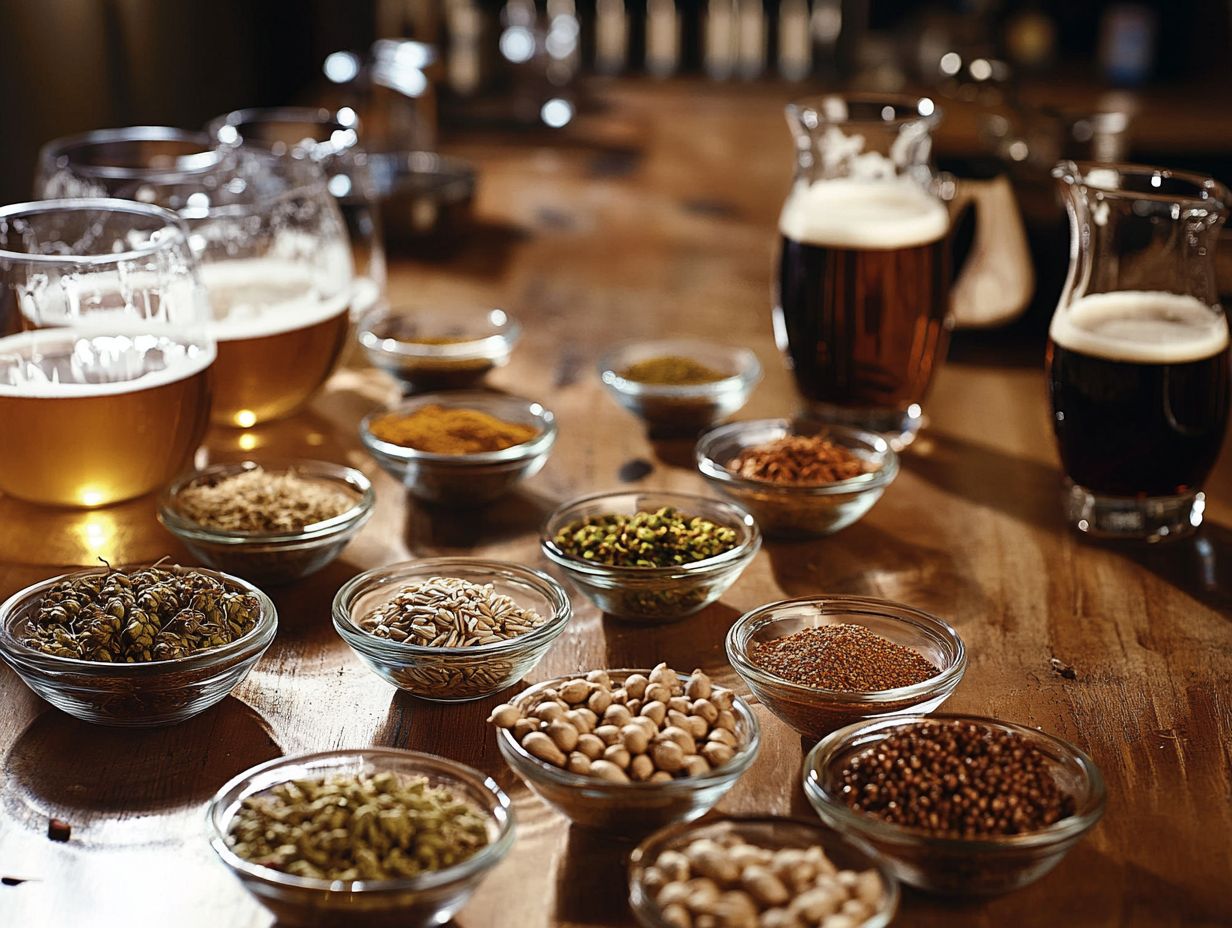
What are the key factors in successful beer ingredient pairing?
The key factors in successful beer ingredient pairing include balancing flavors, complementing ingredients, and considering the style of beer being used.
Try fun combinations like fruity beers with desserts to discover surprising new favorites! Share your favorite pairings or try the suggested combinations!
How do you balance flavors when pairing beer ingredients?
To balance flavors, consider the bitterness, sweetness, and acidity of the different ingredients. A bitter beer may pair well with a sweet ingredient.
Can any ingredient be used in beer pairing?
Theoretically, any ingredient can be paired with beer. However, it’s crucial to consider the ingredient’s intensity and its compatibility with the beer.
Why is it important to complement ingredients in beer pairing?
Complementing ingredients enhances the overall taste of the beer. This creates a more enjoyable drinking experience.
How does the style of beer affect ingredient pairing?
The style of beer significantly affects ingredient pairing. For instance, a hoppy beer pairs well with spicy or savory ingredients, while a rich stout pairs better with sweet or rich ingredients.
Are there any tips for experimenting with beer ingredient pairing?
Start with small batches when experimenting with beer ingredient pairing. Take notes on the flavors and combinations you use to refine and improve your pairings over time.

